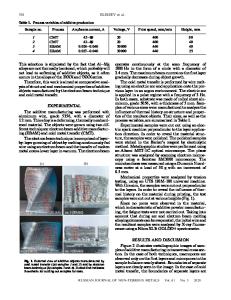Energy Parameters of an Electron Beam and Structure and Mechanical Properties of Composite Coatings
- PDF / 3,002,081 Bytes
- 6 Pages / 595.276 x 790.866 pts Page_size
- 71 Downloads / 383 Views
Russian Physics Journal, Vol. 63, No. 5, September, 2020 (Russian Original No. 5, May, 2020)
ENERGY PARAMETERS OF AN ELECTRON BEAM AND STRUCTURE AND MECHANICAL PROPERTIES OF COMPOSITE COATINGS T. A. Krylova and Yu. A. Chumakov
UDC 621.791.92
An important parameter of non-vacuum electron-beam cladding is the surface density of the input energy that depends on the beam current and the specimen travel speed. The paper presents results of investigation of the effect of the heat input on the structure and properties of composite coatings fabricated by electron beam cladding. The modes of cladding with beam currents of 25 and 40 mA and specimen travel speed varying within 0.5–2.0 cm/s have been studied. It was revealed that the thickness, the dendrite grain size, and the microhardness of the coatings increased, and the volume fraction of the eutectic decreased with increasing specific electron beam power. It is shown that for a low heat input, an austenitic-martensitic structure is formed with carbides in the eutectic and martensite needles. For a large heat input, an austenitic structure with eutectic carbide network is formed. The martensitic structure is formed only along the coating-substrate interface as a result of intense heat removal deep into the substrate material. Keywords: electron beam cladding, heat input, composite coatings, microstructure.
INTRODUCTION One of the sources of failure of steel details of mechanisms is abrasive wear of contacting parts. Intensive wear is also observed when details work in aggressive media. An important method to combat this phenomenon is to produce hardening coatings on the surface of steel details. Nowadays various technologies of surface hardening and modification of working surfaces of steel details are employed, including electroarc [1] and laser cladding [2], plasma spraying [3], boriding [4], nitriding [5], and ionic implantation [6]. An effective method of obtaining protective coatings on the surface of structural materials is electron beam cladding using relativistic beam of electrons extracted inещ the atmosphere [7]. This method permits processing of specimens with practically arbitrary sizes. A powder is adiabatically heated upon exposure to an electron beam, and a high rate of coating formation minimizes the oxidative effect of the atmosphere. Experimental investigations have shown that non-vacuum electron beam cladding of Ti, Mo, and C powders on the low-alloy steel surface considerably improves its mechanical properties. Such coatings possess high microhardness, and their wear resistance is by a factor of 2.4 higher than that of the tempered steel. When studying the non-vacuum electron beam cladding with the self-fluxing NiCrSiB alloy and the addition of the (Nb–B) powder mixture, the hardening coatings with thickness of ~1.4 mm and high hardness were fabricated in [9] on the low-alloying steel surface. It was also shown that the wear resistance of the coating obtained by the method of non-vacuum electron beam cladding of the NiCrSiB + 35% (Nb–B) powder mix
Data Loading...











